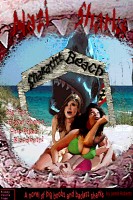Introduction
December 1st, 2008, several friends challenged me to give positive, subtextual analyses of five awful films. Braving the torture of the most brain-sucking, insipid barbarisms ever committed to celluloid, I now bring you the first of my critiques.
Film: Monster a Go-Go (1965)
Subtext: Post-colonialism
Monster a Go-Go is a deep, probing investigation into the conflicts between imperialist oppression and dominated, colonized races that strive to attain their own autonomy and authenticity, rather than be assimilated and lose their Otherness.
The film concerns a space shuttle that has been sent forth to investigate space, to prepare space of colonization. This mission reverberates with 16th century imperialist exploration. As with those explorations, the ship returns, bearing something dangerous for the Empire: the Other. This Other is a monster, possibly the very astronaut first sent out--just as colonialists eventually become a part of the culture they colonize--that begins killing people it finds with radiation and strangulation.
The Empire, Western European society, in this film is represented by two parties: the scientists and the military. Scarcely has there been more adequate representation of the theories of Michel Foucault. Foucault postulated that Truth is a function of Power; that the group with the greatest power determines what is true or false. The military, which is symbolic of power, has at it's command science, which determines what counts as true or false.
The presence of the Other always creates between itself and the Empire what is called Difference. While the autonomy of the Other depends upon the survival of Difference, the Empire's Power depends upon the destruction of Difference.
Thus in Monster a Go Go, Difference is represented by the radiation that emits from the monster. This radiation is referred to by one of the scientists as 'contaminating.' In one scene, the monster appears to sunbathing women, who run away, afraid of contamination by the Other. Otherness is not acceptable to the Empire.
Initially the monster is in the wild--representative of the savage, uncivilized state Western society presumes is held by those it hasn't assimilated. In the wild it kills only those that emerge from cars or helicopters, indicating a rejection of industrialist forces of conformity.
Finally, however, a scientist manages to take possession of the monster, where he gives it an antidote to try make it normal. This is an obvious reference to education, whereby the 'savage' or non-westerner is made to think according to European standard--the standard of Truth prescribed by Power. While institutionalized in this manner, the monster does no harm, and things go quiet.
Eventually the monster rejects its bondage and escapes the institution, running back into the wild, where it proceeds to terrorize with its Otherness, again killing a truck driver.
The monster then goes into the city. The city is the center of civilization. The presence of the Other in civilization's center risks contaminating civilization with savage Otherness. Hence, the radiation, we are told, can contaminate everyone within a fifty-mile radius.
The military at this point is given command. Where socializing forces of education have been rejected, sheer institutionlized Power must be turned against the Other to bring it into conformity or to destroy it.
In the meanwhile the scientists are trying to figure out and analyze the monster. If Knowledge can explain away Difference, to place the Other under a reductionist microscope, its autonomy is held in check.
However, the scientists do not succeed. The film ends with the monster cornered by the military and the scientists, only to instantly vanish. It has no place in the ontology of the Empire. If it will not conform, its very existence is not acknowledged.
In a final, puzzling moment, we are told that the astronaut has actually been found in a boat out to sea, alive and normal. The monster, then, was both a monstrous doppleganger, indicating how the Other and ourselves are potentially the same; and both the astronaut and not the astronaut, to emphasize the potential within each individual to return to attain one's own autonomy outside of the bounds prescribed by Western hegemony.
Topping off this whole tale is a voice-over in the style of a cautionary educational short, or a piece of propaganda. The narration announces, prior to each death or accident, a trite, cautionary statement, "if only," to emphasize the errors surrounding the treatment of the Other. It is vehemently on the side of Power, warning the viewer of the dangers of allowing the Other excessive freedom: a reactionary statement to the rights moments of the '60s, at which time this film was made.
The final lines of the narration solidly emphasizes the victory of Power and Empire, and its ability to dictate what is true and real, "The lines between science fiction and science fact are microscopically thin." Indeed, it is Power that decides what is fact and what is fiction.
This film is recommended to all rights groups as a reminder of the oppressive forces that one must fight against for one's cultural and personal autonomy. It is worth watching for its ideological power, capacity for consciousness raising, and empowering, sympathetic depiction of a being completely erased from existence simply for being different.
Help make this site more interesting through discussion:
Subtextual Criticism Challenge: Monster a Go-Go
Author: Jared Roberts
Subscribe to:
Post Comments (Atom)

0 comments:
Post a Comment